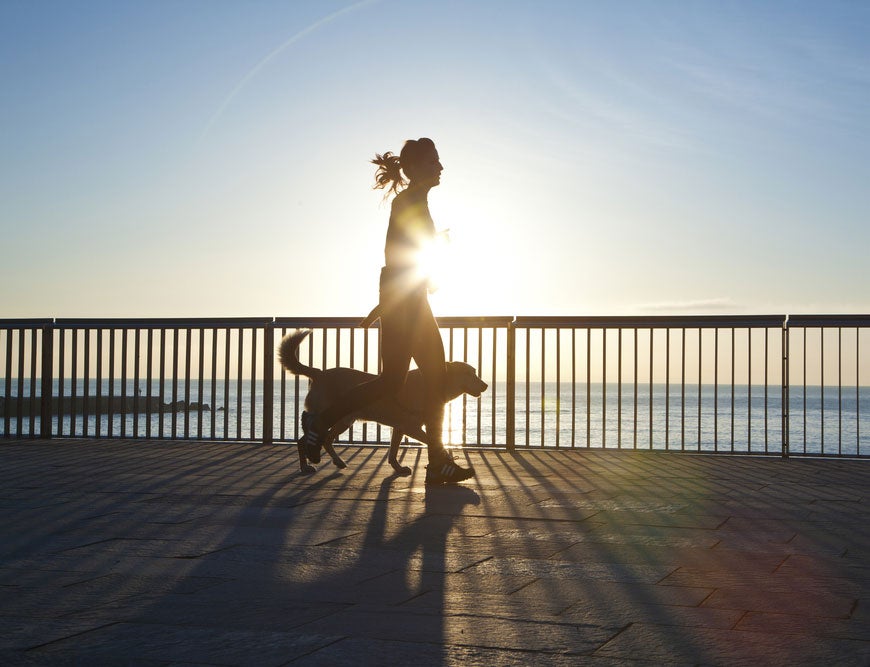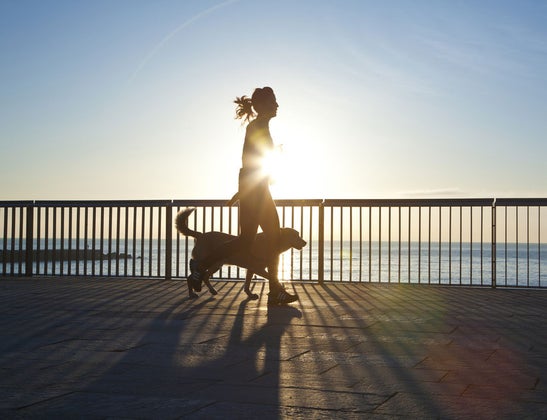4 Tips For Running With Your Dog

Photo courtesy of Shutterstock.com

Make your favorite furry friend your go-to running buddy!
Pounding the pavement with your puppy can do more than put a smile on your face. In a study published in the Journal of Personality and Social Psychology researchers found that dogs are even better than human friends at helping us cope with stress. Exercising with your pet improves its health as well by warding off joint issues, liver disease and diabetes. Aching to take Fido out for a jog? Follow these guidelines to make your pooch the perfect running partner.
Physical First
Lindsay Stordahl, a Fargo-based runner, has turned running with dogs into a career. As the founder of dog-running service Run That Mutt, she logs about 15 miles per day with various breeds. Stordahl’s experience has taught her some important pooch precautions. Most importantly, you must get your pet a checkup before you take her out for a trot.
Dr. Janet Grace of Five Points Animal Hospital in Nashville, Tenn., sees a number of pups who regularly run with their owners. Grace believes an exercise-specific checkup should have an orthopedic focus to determine any hereditary issues. For example, your vet will be able to tell if your dog’s ball-and-socket joints are prone to hip dysplasia. “If you start running with your pet, and he or she has looseness or laxity in the hip joint, the problem will only get worse,” says Grace. Be specific with the vet about your training plans so she can best assess your pooch’s preparedness.
Your dog’s age is another major consideration. “We do not want to take dogs running until they are skeletally mature,” Grace says, warning that the growth plate must be completely closed before our four-legged friends can stride safely. This may take one to two years, depending on breed. That’s not to say you should prevent your puppy from playing fetch in the park. “Let your dog be a dog,” Grace says. “Just don’t start any high-impact exercise until she’s ready.”
Too Hot To Trot
If your vet gives the green light for a running routine, use common sense. Just as you had to go slow and take breaks when you first started running, so does your dog. Don’t head out for a fast tempo run the first time Trixie tags along. Also, avoid leashing up during the dog days of summer.
“Dogs don’t sweat,“ Grace cautions. “The only way they can compensate is by panting, and at some point panting will not be enough to cool them down. Dogs will run with you until they collapse.” If the weather is warmer than 70 degrees, be extremely vigilant, keeping coat-length in mind. Siberian huskies will feel the heat much faster than Labradors. Even if you’re out for a run in ideal weather, stop if your dog wants to, and be sure to carry enough water for your comrade. Grace says, “You should never force your dog to do X number of miles.”
If the sun is baking the asphalt, it can also burn your dog’s delicate pads. Additionally, paws are susceptible to abrasion, Grace notes. That’s why owners should ease their often over-eager companions into an exercise regimen and allow their pads time to build calluses.
Dog Leashes And Loot
Sparky doesn’t require much in the way of gear. A short leash—six feet or less—will give you better control, and a harness will discourage pulling while protecting your dog’s fragile neck. If your buddy lacks leash manners, buy him a“no-pull” harness to teach him proper etiquette. Hook well-behaved canines up to a hands-free leash that encircles your waist.
Doggie backpacks allow your pal to carry his own water and travel bowl. Stordahl says she often equips larger breeds with a pack, as they enjoy having a “job to do.”
If you notice Baxter has sensitive paws when it comes to ice, heat, snow or trail rocks, you can outfit him with protective doggie boots. Of course, some dogs will simply decide that footwear—be it yours or theirs—is only for chewing.
Mutt Manners
Early leash training will benefit both you and your pup. Work on obedience commands such as heel, sit, stay and “leave it” (used when Roxy finds a piece of trash). A puppy’s growing months are a perfect time to teach good behavior that will last a lifetime. Simply learning the heel command will go a long way when it comes to running success. And speaking of conduct, be sure to train yourself to scoop up anything your pooch leaves behind!
Jennifer Chesak is a Nashville-based freelance adventure and travel writer with a passion for the marathon. Her schipperke, Fiver, demands to go along on Jennifer’s shorter training runs.